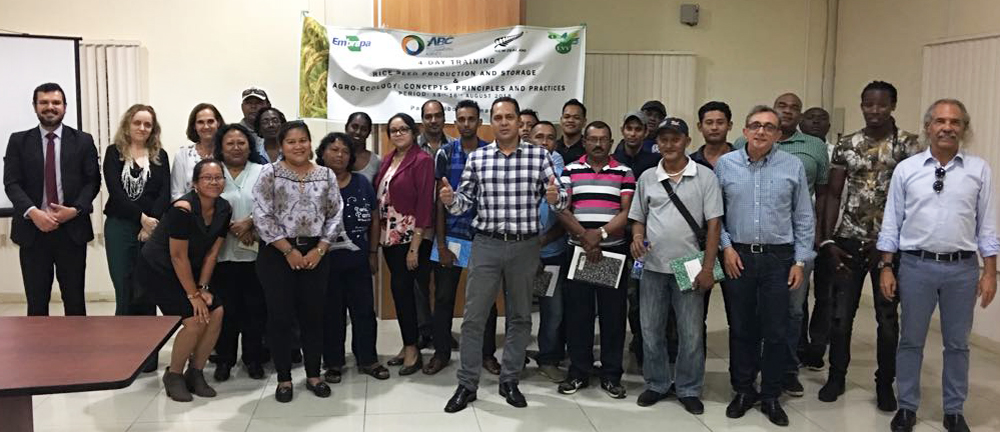Upland rice research project by Embrapa ends in South American country
Upland rice research project by Embrapa ends in South American country
Researchers from Embrapa Rice and Beans train technicians and conduct experiments and a seminar, the final activities of project to support the development of upland rice in Suriname
Having started in April 2016, the project “Support to the improvement of rice cultivation in Suriname” is a trilateral action that has involved Brazil (Embrapa and the Brazilian Cooperation Agency, ABC), New Zealand (Embassy of New Zealand in Brazil and Landcare Research) and Suriname (Ministry of the Agriculture of Suriname). The research aimed at offering sustainable technologies, with the purpose of increasing rice yield in the Maroon community of this South-American country, which has ceased to be a Dutch colony for little over 40 years.
Since 2016, the researcher Adriano Stephan Nascente, technical coordinator of the project, visited the country at all the stages of the experiments, offering guidance about best practices in sowing, in fertilization, in pest, disease and weed control, and in harvesting, receiving support from the researcher of the Ministry of the Agriculture of Suriname, Ruby Kromokardi. In his studies, Nascente assessed different rice cultivars, three from Suriname and four from Brazil (the Brazilian varieties were the most productive ones: BRS Esmeralda, 2,903 kg/ha; BRS Sertaneja, 2,802 kg/ha; and BRSMG Curinga 2,255 kg/ha), and also analyzed he suitable doses of nitrogen, phosphorus and potassium, the nutrients rice requires in larger amounts. The project approached and disseminated the use of good agricultural practices such as: fertilization, plant spacing and populations; and weed control to promote a significant increase in rice grain yield in the country.

Smallholders in Suriname use rudimentary techniques, with productivity below 1,000 kg/ha. The actions promoted by the project, with the adoption of suitable technology, provided close to 3,000 kg/ha. The significant increment in grain yield consequently cntributes to food security in the country. The work included experiments, technical capacity-building events, setup of Demonstration Units, and field days to present the production potential of the cultivars with the use of technologies.
The Ministry of the Agriculture of the Suriname requested the execution of a new project, especially aimed at disseminating the validated technologies for Maroon communities in the country. Moreover, they were hoping to expand technical cooperation for the crops: irrigated rice, soybeans and maize.
Partnership that stimulates new actions
Thanks to the good results obtained in Suriname, the New Zealand government decided to support another project, now for the development of upland rice crops in Maranhão state. Conducted during the period from August 2017 to July 2018, the activities aimed at providing increased grain productivity and improving the quality of the rice produced by family farmers through the dissemination and validation of sustainable crop technologies.
The actions reached the towns of Igarapé do Meio, Itapecuru Mirim and Codó. The project was led in partnership with their town governments and with other institutions such as MST and Farmer Associations in Maranhão state. The average yield in the Demonstration Units in this project was of 4000 kg/ha, four times the average obtained by farmers in the state.
Translation: Mariana Medeiros, from edited version.
Henrique de Oliveira (MTb/GO 1.960)
Embrapa Rice and Beans
Press inquiries
arroz-e-feijao.imprensa@embrapa.br
Phone number: +55 62 3533-2108
Further information on the topic
Citizen Attention Service (SAC)
www.embrapa.br/contact-us/sac/

